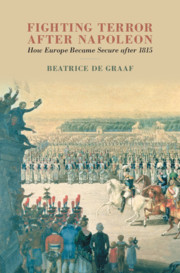Book contents
- Fighting Terror after Napoleon
- Fighting Terror after Napoleon
- Copyright page
- Contents
- Figures
- Maps
- Tables
- Acknowledgements
- Prologue
- 1 Introduction
- 2 Providence in Paris
- 3 Balancing in a Climate of Distress
- 4 ‘A Moderate Occupation’
- 5 Fausses nouvelles and ‘Blacklists’
- 6 Fighting terroristes Together
- 7 The Price of Security
- 8 Fortress Europe
- 9 Beyond Europe
- 10 Conclusion
- Bibliography
- Index
8 - Fortress Europe
Constructing the ‘Wellington Barrier’
Published online by Cambridge University Press: 12 September 2020
- Fighting Terror after Napoleon
- Fighting Terror after Napoleon
- Copyright page
- Contents
- Figures
- Maps
- Tables
- Acknowledgements
- Prologue
- 1 Introduction
- 2 Providence in Paris
- 3 Balancing in a Climate of Distress
- 4 ‘A Moderate Occupation’
- 5 Fausses nouvelles and ‘Blacklists’
- 6 Fighting terroristes Together
- 7 The Price of Security
- 8 Fortress Europe
- 9 Beyond Europe
- 10 Conclusion
- Bibliography
- Index
Summary
One of the hallmarks of European peace and security after Napoleon was the system of fortifications in France and Belgium. Prussia’s attempt to have the Netherlands contribute to the cost of restoring forts in Luxembourg was met with refusal by King Willem I, and exemplified the fact that the fear of French terror was diminishing by 1818 – so much so that King Willem I’s refusal to cooperate with Prussia had no wide-reaching consequences. The fortification projects in the 1820s required an enormous investment and were not without corruption. The 'Wellington Barrier' was constructed in Belgium, but in 1839, the new Belgian king Leopold decided to dismantle the fortifications along the barrier, favouring industrialization, modernization and the expansion of Belgian cities. Maintaining the fortresses also proved too expensive, and the Belgian army lacked the military numbers required to defend the fortresses on its own. The expensive, skilfully crafted fortifications, such as at Oudenaarde, Mons and Ostend, were demolished, with the exception of the National Redoubt in Antwerp.
- Type
- Chapter
- Information
- Fighting Terror after NapoleonHow Europe Became Secure after 1815, pp. 357 - 426Publisher: Cambridge University PressPrint publication year: 2020

